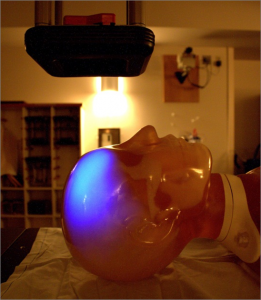Thayer & Geisel researchers are excited to have won a four year NIBIB R01 grant entitled “Optical Cherenkov Calibration for Human Radiation Therapy” that builds upon a fundamental technological discovery made at Dartmouth, and patented into a translational technology, by Professors Pogue, Gladstone and Jarvis along with PhD students Adam Glaser & Rongxiao Zhang.
Researchers in the Medical Physics Program at Dartmouth have used optical imaging of Cherenkov emissions to map the radiation dose de livered to tissue. This the first time ever that radiation dose delivered to tissue has been directly imaged with high spatial and temporal resolution. Their approach represents a complete paradigm change in how radiation therapy is documented and archived for both real time control and quality audits.
livered to tissue. This the first time ever that radiation dose delivered to tissue has been directly imaged with high spatial and temporal resolution. Their approach represents a complete paradigm change in how radiation therapy is documented and archived for both real time control and quality audits.
Professor Pogue remarked, “From a practical standpoint, using optical technology to image Cherenkov emissions is significantly simpler than most dosimetry tools currently available to clinicians. The challenge is to maintain quantitative accuracy in order to be competitive in documenting the dose delivered to tissue.”
Through pilot studies of breast cancer patients undergoing radiotherapy, the grant project will advance methods to correct for tissue curvature and tissue optical properties, two of the most dominant factors that alter the linear relationship between dose and Cherenkov emission. Researchers will focus on reducing errors in alignment of patients for daily treatments by using Cherenkov imaging to verify the combined on-patient delivery of the beam, using vascular patterns of the breast that are visible in treatment beam images. The team will also explore the similarity of Cherenkov intensity to thermoluminescent diode measurement, to determine if this solution is more accurate and easier to implement.
This study is being conducted in partnership with leading companies that are advancing the methods for patient surface scanning, tissue optical property imaging and Cherenkov imaging system development, ensuring that the discoveries made can be translated into a commercial venture.
The team is actively looking to recruit researchers in Medical Physics or Electrical Engineering to work on this project, and expects to use this funding to support several Thayer PhD students in the coming years.
